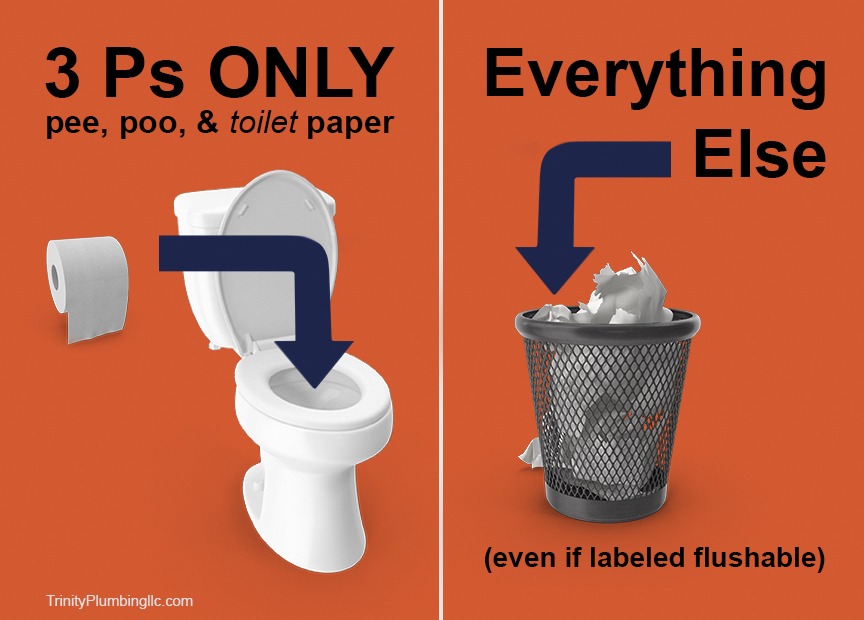
Wet Wipes
In 1960, the first wet wipe was introduced to wipe your hands after eating at restaurants. Wipes have a long history, but the concept is evolving. Now there are wipes for practically every need:
- baby wipes
- disinfectant cleaning wipes for household & office
- make-up remover wipes
- anti-acne pads
- toilet wipes (alternative to toilet paper)
- pre-moistened towelette hand wipes (offered at restaurants along with the silverware)
- pet care wipes (for eyes, ears, and dental)
- industrial wipes (for cleaning greasy tools and hands)
- pain relief wipes (insect bites, hemorrhoids, disinfect/injury)
- medical wipes (for sterilization & infection prevention)
- insect repellant wipes
- mold & mildew removal wipes
- car detailing wipes
- sanitizer wipes (sales have dramatically increased since the Covid outbreak)
Wet wipes are a convenience that consumers will gladly pay for. BUT wipes don’t belong in the toilet, no matter what the label says. When you use wipes, dispose of them in the garbage. No Wipes in Pipes – Wipes Clog Pipes!

Wipes Clog Pipes
Wipes usually go down the toilet drain just fine, BUT there are elbow bends in the plumbing pipe from your house to the street. The wipes start to bunch up in these elbows. As the months go by, the wipes accumulate. This is a ticking time bomb because it will become a complete blockage and BOOM!!! – there’s a yucky sewage back up in your house. (It’s time to call the plumber!).


Wipes Cause Damage
For years, wastewater treatment facilities have been begging people to STOP flushing wipes, even if the label says it’s safe. The wipes don’t break apart or dissolve in water – they are breaking equipment, burning out pumps, clogging sewers and in the end, increasing already expensive water bills.
People seem to think that if an item fits down the sink drain or toilet then it must be ok to do so. But cities worldwide are finding out the hard way that you shouldn’t flush your wipes.
In 2018, a small coastal town in England spent 8 weeks removing a major blockage in a sewer line. Officials described the blockage as “a monster” because it measured 210 feet wide and weighed 90 tons (that’s 18,000 pounds).
Fatbergs
While major blockages sound like unusual events, unfortunately they have become so common that they have their own Wikipedia page, Fatberg.
A fatberg is a rock-like mass of waste matter in a sewer system formed by the combination of flushed non-biodegradable solids, such as wet wipes, and congealed grease or cooking fat. Fatbergs have occurred in cities and towns worldwide, with the rise in usage of disposable (so-called “flushable”) cloths.
wikipedia
We rarely give thought to our municipal services (like sewerage treatment facilities), until we have to revert back to caveman days and live without them.
For 6 months, the wastewater system in a London suburb was shut down while they dug up streets to remove a 15 ton fatberg.
wikipedia
These sewer blockages take considerable resources to clean up.
What took $2Million & 2 Months to clean up?! A fatberg that measured 820 ft long weighing over 260,000 pounds (found in Whitechapel, London – September 2017).
wikipedia
These sewer blockages can also have an environmental impact.
1.2 million US gallons of sewage spilled into Jones Falls was caused by a fatberg of congealed fat, wet wipes, and waste (discovered under the streets of Baltimore, Maryland in September 2017).
wikipedia
No Wipes in Pipes
In June of 2020, the City Of Atlanta Department of Watershed Management started a public awareness campaign: No Wipe In Pipes.
These products do not break down easily, are not meant to be flushed, and can cause millions of dollars in system and equipment damage. Be a part of the solution!
atlantawatershed.org
How can you make a difference?
Place used wipes in the trash…EVERY single time! Trash Your Wipes, Not Your Pipes!
Wastewater experts say the only thing you should flush down your toilet are the three P’s of plumbing — pee, poo & (toilet) paper.








